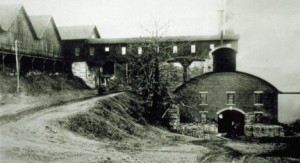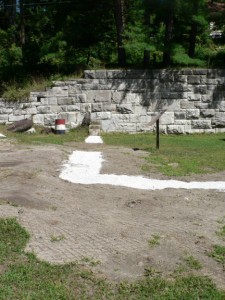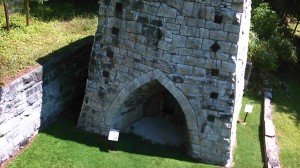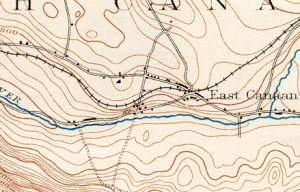Where (and what) was the casting shed?
(this post came from the old website, with a few modifications)  A question we’re frequently asked (not as frequently as we’re asked “What was this place, anyway?” but still pretty frequently) concerns the place of the blast furnace in the overall scheme of things at Beckley. After all, there’s this magnificent stone column standing there, and somehow it looks more like a work of Neolithic sculpture than an industrial artifact. So, we don’t blame people for being a little disoriented and confused! One of our most important tasks as Friends of Beckley Furnace is to “interpret” what you see there — to make it comprehensible. Toward that end, since the stone column at Beckley Furnace was the furnace itself, and the furnace was only a part of a much larger industrial facility, we’ve started making it easier to understand that the furnace was actually located in a long-vanished building called the casting shed. As well as containing the furnace itself, the casting shed also was the place where the molten iron was drawn from the furnace into impressions in a bed of casting sand, making the familiar sow-and-piglet pattern, which gave rise to the term “pig iron”. To start with, here’s a photograph of Beckley Furnace in operation around 1896 (before the fire of 1896):
A question we’re frequently asked (not as frequently as we’re asked “What was this place, anyway?” but still pretty frequently) concerns the place of the blast furnace in the overall scheme of things at Beckley. After all, there’s this magnificent stone column standing there, and somehow it looks more like a work of Neolithic sculpture than an industrial artifact. So, we don’t blame people for being a little disoriented and confused! One of our most important tasks as Friends of Beckley Furnace is to “interpret” what you see there — to make it comprehensible. Toward that end, since the stone column at Beckley Furnace was the furnace itself, and the furnace was only a part of a much larger industrial facility, we’ve started making it easier to understand that the furnace was actually located in a long-vanished building called the casting shed. As well as containing the furnace itself, the casting shed also was the place where the molten iron was drawn from the furnace into impressions in a bed of casting sand, making the familiar sow-and-piglet pattern, which gave rise to the term “pig iron”. To start with, here’s a photograph of Beckley Furnace in operation around 1896 (before the fire of 1896):  (the source of the image is “Scrap Book of North Canaan”)
(the source of the image is “Scrap Book of North Canaan”)
In the lower right corner of the picture, you will see the casting shed, the building with the curved roof. Running horizontally across the middle of the picture is the passageway used to transport the charcoal, iron ore, and limestone from the top of the charging wall (at extreme left, to the left of Lower Road) to the top of the furnace.
Now, how to relate that to what you see at Beckley Furnace today: You’ll see that we have outlined the foundation of the casting shed you see in the picture above with limestone.
The gap in the outline is where the casting shed door you see in the picture above was located. (This photo is looking down on the casting shed’s western wall. The furnace is off screen to your left. The white limestone shows where the walls of the casting shed once stood.)
In this photo, we’ve backed up a bit from the one above. (Note that the chain link fence that protected the furnace stack during restoration is no longer present today).
This photo is looking westward, from the ruins of the boiler house. The furnace appears on your right in the photo, and Blackberry River is off screen to your left (once again, that chain link fence isn’t there anymore).
Looking northward, toward the remains of the north wall of the casting house (and where we took the first photo in this set)
So, that outlines where the casting shed was!!
Why do you suppose they put the furnace in a building to begin with? Well, one important reason was to protect the molten iron from rain or snow. Have you ever seen what happens when a few drops of water land in a very hot frying pan? Now, remember that the molten iron was far hotter than the hottest frying pan….what might have happened?











